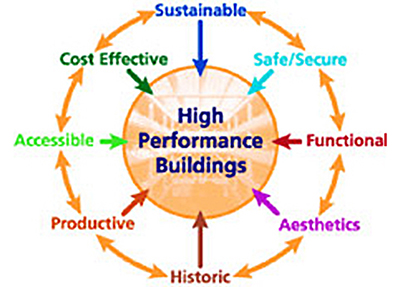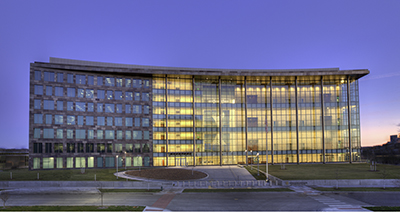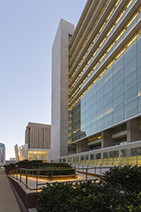Overview
Within This Page
"We hold these truths to be self-evident: that all men are created equal..."
— Declaration of Independence, July 4, 1776
In daily life, as we maneuver through society, nothing is more important yet taken for granted more often than access. For millions of people with disabilities, the access that most of us take for granted is difficult, impossible, or achievable only with the intervention of a third party. We live in what is considered an independent society, yet independent access to programs, facilities, and employment is not easily achievable by many. Physical access is historically the arbiter of success and the source of opportunity in education, employment, and social freedom. Thus, accessibility is a civil rights issue for many people with disabilities and for society. See the History of Accessible Facility Design to learn more.
Whole building design requires a balanced and integrated approach to all the design objectives, including accessibility.
So information in these Accessible pages must be considered together with other design objectives and within a total project context in order to achieve quality, high-performance buildings.

Definition and Goals of Accessible Design
Principles and a process that support accessible design include:
Understand the Laws, Codes, and Standards that Apply
Know what laws apply and which standards they reference depending on the type of project:

Image Courtesty of Bill Brack
- Project developer (government vs. private entity)
- Project use (residential, retail, office, etc.)
- Funding sources (public vs. private)
- Building type (new construction vs. renovation)
- Housing type (Single family vs. multifamily)
- Housing ownership (Condo vs. rental)
See here for more information.
Plan for Access
Successful integration of accessible design into the whole design process requires careful consideration of potentially conflicting goals for a project at its earliest stages. The design team must identify conflicts as well as synergies in order to meet project challenges. Sustainability, historic preservation, safety/security, and aesthetics can be problematic for accessibility. The following are a few examples:
-
A parking lot for a new state office building is designed with pervious pavers to meet sustainability goals. The pavers have openings of 5/8". The pavers located along the accessible route to the building violate the accessibility standard, which requires a maximum opening of 1/2".
-
A historic Federal building has a monumental entrance raised 5'–0" above grade and accessed only by stairs. The State Historic Preservation Officer has determined that altering the entrance to include a wheelchair ramp would destroy historic fabric and irreparably damage the building. GSA's accessibility standard provides an exception that allows the use of an alternative entrance in this case in order to provide access, although persons with disabilities will not be able to enter the building through the main entrance.
-
A new city courthouse has lowered office and corridor lighting power density levels (mandated by local energy code requirements to reduce energy consumption). Persons with low vision, public and staff, are adversely affected by the requirements because they require brighter lighting to facilitate functioning in the spaces.
-
A new Federal courthouse has 4'–0" x 4'–0" security planters installed at the perimeter of the site. The planters are spaced 2'–10" apart and cross the accessible route into the building. The planters are in violation of GSA's accessibility standard, which requires a minimum clearance of 3'–0" between the planters crossing the accessible route.
-
An architect has designed a performing arts center on a steeply sloping site. The entrance location requires persons on foot to negotiate a 10'–0' downhill change in level from the street, where there is public transportation available. The architect has designed a series of landscaped terraces and stairs to get from street level to the plaza in front of the entrance, but has not included ramps because they would "compromise" his design. Instead, he uses an enclosed elevator for disabled persons. Two months after the center opens, the elevator has mechanical problems and is out of service.
Identify potential conflicts at the conceptual level of a project in an integrated design team environment to avoid problems and conflicts such as the examples cited. This results in a thoughtful and successful project for all of the stakeholders.
- Plan for access into the facility
- Plan the location of accessible entrances and facility access points when positioning buildings on sites to:
- Limit travel distances for people with disabilities from site arrival points, such as public sidewalks, public transportation stops, and parking, to accessible building and facility entrances.
- Provide accessible routes which require low-effort. Where ever possible, provide walks with no more than 1:20 running slope over ramps. When ramps are required design ramps with lower running slopes and not at the maximum permitted 1:12 permitted.
- Provide equivalent access and travel options to those provided for people without disabilities.
- Provide equivalent, safe, easy, and compliant access into the facility while maximizing security.
- Plan the location of accessible entrances and facility access points when positioning buildings on sites to:
- Plan for access to spaces within the facility
- Plan the layout of facility spaces to best accommodate all persons, including people with disabilities, such as:
- Layout spaces whenever possible to limit travel distance between elements within the space.
- Group and centralize spaces to limit the amount of travel required between the spaces. For instance, in a residential garden style apartment complex, centrally locating the swimming pool and associated amenities is preferred to locating the swimming pool and amenities at one end of the site.
- Limit the need for travel between levels and the reliance on elevators and lifts, if possible. Although, obviously not an option between stories of high-rise buildings, limiting the need for vertical access on sites and within one and two story facilities and between intermediate levels of high-rise facilities reduces the likelihood of interruptions in the accessible routes, due to elevator/lift malfunctions, and limits the need to install ramps. Where vertical access is required between two levels, ramps designed at low grade, are an option to permit guaranteed access. Ramps can often be creatively integrated into designs without negatively impacting the aesthetics. For instance, integrating ramped access into a swimming pool can avoid the need to install an industrial looking pool lift which can clearly stand out from the overall design.
- Choose lighting options which accommodate people with low-vision.
- Plan the layout of facility spaces to best accommodate all persons, including people with disabilities, such as:
Provide Equal Access and Flexibility
Accessible design benefits all of us at some point in our lives. The goal of accessible design is to provide equal use of the built environment for all people.
Incorporate Best Practices for Accessibility Compliance
Overall best practices to achieve compliance with accessibility regulations should be considered through the entire project cycle, including concept design through construction completion.
Go Beyond Accessibility to Universal Design
Being proactive by planning for flexible design features and products will increase the likelihood of providing equal access over the life cycle of the facility.
Understand the Relationship between Universal Design and Health
An integral part of designing high performance spaces for people with disabilities is incorporating health and wellness into the built environment.
Related Issues
Building Information Modeling
A Building Information Model (BIM) is a digital representation of physical and functional characteristics of a facility. As such, it serves as a shared knowledge resource for information about a facility forming a reliable basis for decisions during its life cycle from inception onward. BIM has the potential to truly integrate accessibility into a project by considering accessibility early and throughout all phases of the project.
Wheeled Anthropometry
Anthropometry is the study of the dimensions and abilities of the human body. The IDEA Center in Buffalo started a major long-range program to establish a database on the anthropometry of wheeled mobility in 1999. This program was initiated as part of the Rehabilitation Engineering Research Center on Universal Design at Buffalo. The U.S. Access Board also began supporting the effort in 2001. A final report on Anthropometry of Wheeled Mobility Project is now available. Click here to download a PDF version of the Anthropometry of Wheeled Mobility Project report prepared for the U.S. Access Board.
Accessible Design and the Relationship to Sustainable Design

Automatic lighting and fixture controls are a win-win for both sustainability and accessibility.
Whole building design must consider the relationship between accessible and sustainable design. Simply put, buildings which are not designed to be accessible are not sustainable. A sustainable building is sensitive to the environment and to its users. Designing buildings for equitable use by the greatest number of people can be achieved by complying with regulatory accessibility requirements, incorporating Universal Design and Visitability concepts, and including adaptable design features.
For some time now, federal, state, and local laws and codes have required accessible design in most building types. When required accessibility is not incorporated at the onset of design or during construction, the risk of complaints of non-compliance and even litigation exists. The result could include required retrofits. Retrofitting buildings due to lack of accessibility compliance, which can create unnecessary waste and energy, is not consistent with the goals of sustainability.
Sustainability and accessibility are intrinsically linked in the design process. For example, when locating buildings on a site to optimize solar orientation, accessibility of the building entrance(s) must be taken into consideration. Will optimal solar orientation create a condition that results in building entrances which are located on a circuitous route from site arrival points? Accessibility must also be considered when selecting sustainable building materials. For example, pervious pavers may be specified to increase water infiltration, but if the installation of the pavers results in wide spaces between them or an unstable ground surface, then accessibility is not achieved.


U.S. Courthouse, Cedar Rapids, Iowa
U.S. Courthouse, San Diego, California
As a result of the ABA, federal buildings are full of accessibility features that are now commonplace and benefit everyone. These include ramps, level door handles, high and low drinking fountains, and service counters with lower sections. Sustainability features such as the large expanses of glass on the facades of these two courthouses provide natural daylight and improve the overall well-being of the building occupants.
Lighting Levels and Low Vision
The Low Vision Design Committee (LVDC) of NIBS recognized that the needs of all occupants of the built environment, including those with low vision, should have adequate lighting levels. Through improvements in designs and operational procedures for new and existing facilities the committee developed Design Guidelines that enhance the function, safety, and quality of life.
21st Century Work Space
The high cost of office space in many urban areas, shrinking budgets for space, the use of telework, flexible work scheduling, hoteling and virtual work, and new technologies such as teleconferencing, web casting, telepresence, virtual phones, and Webex have moved designers to plan downsized office space where the number of work stations is significantly lower than the number of employees in order to maximize the use of space, whether owned or leased. In this arrangement, managers and employees share the same work space and there are no private offices. A docking station for a laptop computer and single or double monitors are provided at each work station. There are no desktop computers, so each person must bring their laptop computer with them on an office day. There are also no reception counters or spaces. Common "break rooms" contain cabinets, counters, refrigerators and microwave ovens that may be shared by multiple organizations. Common shared printers are kept to a minimum, and there are no individual printers. There are also communal coat closets adjacent to the work space for coats, umbrellas, etc.
GSA, a Federal agency, is using a system known as "Bookit" for employees to reserve work stations in this new type of work environment. Employees can reserve their work space for a maximum of two weeks in advance, and there is no guarantee that they will get the same work station even on two consecutive days. Work stations are reserved for an hour from the check-in time on each reservation day. When employees arrive, they notify the "Bookit" system so that the space cannot be taken by another person. Small individual lockers with electronic combination locks hold valuables and essential items. Common storage space such as lateral files are limited but available for program files and documents required for employees to do their jobs. There are also "touchdown stations" that are not subject to the "Bookit" system which can be used by employees who do not book their workstations in advance because of lack of availability or because they are only in the office for part of a work day. Private telephone conversations and small meetings are accommodated in small glass enclosed rooms with tables and three or four chairs, adjacent to the common work space. These rooms are used on an ad hoc basis. Larger conference rooms are also managed through the "Bookit" system and do not belong to any specific organizational entity, so it is possible that larger meetings may take place in other locations than where the specific organizational space is located.
Employees with disabilities who require special assistive technology, as well as certain employees who use a large amount of technology required for their jobs that is not portable, require special consideration and exceptions to the general way the space is utilized, and are provided with dedicated work stations. However, because persons with certain disabilities require provisions such as higher light levels and significant glare reduction, audio amplification, etc., commonly shared office space could prove to be an obstacle for them even though they have dedicated work stations. Consider including adjustable height workstations as well to allow for variation and flexibility in work space needs. (See also Changing Nature of Organizations, Work, and Workplace.)
Relevant Codes, Standards, Laws, and Guidelines
Codes and Standards
- ASME A17.1/CSA B44 Handbook on Safety Code for Elevators and Escalators
- ASME A18.1 Safety Standard for Platform Lifts and Stairway Chairlifts
- International Code Council (ICC)—ICC is the secretariat for the following:
- National Fire Protection Association (NFPA)
- Uniform Federal Accessibility Standards
Guidelines
- Americans with Disabilities Act and Architectural Barriers Act Accessibility Guidelines for Buildings and Facilities
- Fair Housing Accessibility Guidelines
Laws
-
Americans with Disabilities Act (ADA): The ADA prohibits discrimination on the basis of disability in employment, State and local government, public accommodations, commercial facilities, transportation, and telecommunications. It also applies to the United States Congress.
-
Architectural Barriers Act (ABA): The Architectural Barriers Act (ABA) requires that buildings and facilities that are designed, constructed, or altered with Federal funds, or leased by a Federal agency, comply with Federal standards for physical accessibility. ABA requirements are limited to architectural standards in new and altered buildings and in newly leased facilities. They do not address the activities conducted in those buildings and facilities. Facilities of the U.S. Postal Service are covered by the ABA.
-
Fair Housing Amendments Act of 1988 (FHA): The Fair Housing Act, as amended in 1988, prohibits housing discrimination on the basis of race, color, religion, sex, disability, familial status, and national origin. Its coverage includes private housing, housing that receives Federal financial assistance, and State and local government housing. It is unlawful to discriminate in any aspect of selling or renting housing or to deny a dwelling to a buyer or renter because of the disability of that individual, an individual associated with the buyer or renter, or an individual who intends to live in the residence. Other covered activities include, for example, financing, zoning practices, new construction design, and advertising.
- Rehabilitation Act of 1973, Section 504 & Section 508: The Rehabilitation Act prohibits discrimination on the basis of disability in programs conducted by Federal agencies, in programs receiving Federal financial assistance, in Federal employment, and in the employment practices of Federal contractors. The standards for determining employment discrimination under the Rehabilitation Act are the same as those used in title I of the Americans with Disabilities Act.
Additional Resources
Federal Mandates, Legislation, etc.
- Americans with Disabilities Act (ADA)
- Architectural Barriers Act (ABA)
- Fair Housing Amendments Act of 1988 (FHAA)
- Fair Housing Accessibility Guidelines
- Help America Vote Act
- Section 504 of the Rehabilitation Act of 1973
Organizations
- ADA & IT Technical Assistance Centers
- ADA National Network
- International Living Future Institute, Living Building Challenge
- U.S. Green Building Council LEED for Neighborhood Development
Federal Agencies
The major resource for guidance on accessible design is the U.S. Access Board (Access Board). The Access Board is an independent federal agency devoted to accessibility for people with disabilities. Key responsibilities of the Board include developing and maintaining accessibility requirements for the built environment, transit vehicles, telecommunications equipment, electronic and information technology, and medical diagnostic equipment providing technical assistance and training on these guidelines; and enforcing accessibility standards for federally funded facilities. For additional resources, see the Access Board's Listing of Other Resources. Animations of many accessibility solutions can be found on the Animations page.
-
Department of Defense—ABA Accessibility Standard for DOD Facilities
-
Department of Housing and Urban Development (HUD) Office of Fair Housing and Equal Opportunity (FHEO)—HUD enforces the Fair Housing Act under regulations to the ABA and has issued guidelines under this law (the Fair Housing Accessibility Guidelines) which cover multi-family housing. Information is also available on how to file a complaint with HUD under the Fair Housing Act. HUD's website also addresses access under Section 504 of the Rehabilitation Act. See also HUD's Accessibility Requirements for Buildings.
-
Department of Justice (DOJ)—DOJ offers technical assistance on the ADA Standards for Accessible Design and other ADA provisions applying to public accommodations and commercial facilities, including businesses, nonprofit service agencies, and state and local government programs and services; also provides information on how to file ADA complaints. Many of its technical assistance letters are available online.
- ADA Information Line for documents, questions, and referrals:
(800) 514-0301 (voice)
(800) 514-0383 (TTY)
- ADA Information Line for documents, questions, and referrals:
- Department of Veterans Affairs (VA)—Barrier-Free Design Standard
- General Services Administration (GSA)—Accessible Facility Design
- U.S. Navy—Accessibility Requirements for Navy and Marine Corps Facilities
- U.S. Park Service—Director's Order #42: Accessibility for Visitors with Disabilities in National Park Service Programs and Services
- U.S. Department of Transportation—Accessibility
- U.S. Postal Service— Handbook RE-4 Standards for Facility Accessibility
Publications
- The 1995 Accessible Building Product Guide by John P.S. Salmen and Julie Quarve-Peterson. New York, NY: John Wiley & Sons, Inc., 1995.
- Access by Design by George A. Covington and Bruce Hannah. New York, NY: John Wiley & Sons, Inc., 1996.
- The Accessible Housing Design File by Barrier Free Environments, Inc. New York, NY: John Wiley & Sons, Inc., 2010.
Others
- Building Research Information Knowledgebase (BRIK)—an interactive portal offering online access to peer-reviewed research projects and case studies in all facets of building, from predesign, design, and construction through occupancy and reuse.








